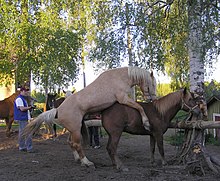Natural jump
In contrast to the artificial insemination is natural service the natural way of the mating of a female pet or farm animal by a male specimen for the purpose of fertilization .
The natural jump can take place in two forms. Either as a pasture jump , in which the male farm animal is placed on a pasture together with the female farm animal ready to mate, or by the hand, where the mating is carried out under the control of humans. Pasture jumping is the most natural form, but there is a risk that the animals will not accept one another or that injuries may result. When covering on the hand, these risks are largely ruled out and the female farm animal does not have the opportunity to evade covering.
The " artificial insemination " stands opposite the natural jump . While the success rate for natural jumping is around 85%, it is significantly lower for artificial insemination at around 65%. On the other hand, artificial insemination offers other advantages, such as the prevention of breeding diseases and the possibility of targeted crossbreeding of desired properties (see also animal breeding ).
The natural leap in horse breeding
In horse breeding , artificial insemination of thoroughbreds is prohibited. This ban was enacted to prevent only a few stallions from fathering entire generations through artificial insemination and thereby considerably reducing the breed's gene pool . In all other horse breeds , it has become the standard for the most valuable animals, as the transmission of diseases during mating is particularly excluded. In addition, a stallion can only cover around 70 mares in natural jumping in a covering season (January to August) , while significantly more mares can be served with artificial insemination . Since a stallion has to undergo a number of medical examinations in order to be approved for artificial insemination and these examinations have to be repeated after each natural jump because of possible infections, approval for artificial insemination for a stallion usually means the end of the natural jump.
In order to avoid risks during mating, pasture jumping is only practiced relatively rarely. When covering by the hand, the mare is usually fixed in the stud stand in such a way that she cannot injure the stallion under any circumstances. In extreme cases, this can lead to the mare's hind legs being tied up and connected to a front leg in order to prevent any step. Some animal rights activists see this as raping the mare. If necessary, the mare is also protected by blankets so that she can not be injured by the stallion's hooves and neck bite .
The pasture jump is much more time-consuming because the stallion is normally not brought together with a single mare, but with a herd of mares . To do this, the mares must first be accustomed to each other before the stallion can be added to the herd. The time required as a result makes it impossible to bring the mare to the stallion's location for just one day.
